
Create an Amazon Business Account

During its quite short colonial history, Italy occupied several African territories such as Eritrea, Somalia and Libya: rather vast and interesting dominions. It is less known, on the contrary, the story of another small and far colony in China: Tientsin (a town ca. 200 km south of Beijing) and the so-called commercial quarters of Shanghai and Beijing (under the direct sovereignty of Rome as from 1901, after the failed Boxers' revolt), two small Italian enclaves inside the Chinese state, which hosted Italians as well as larger English, French, Russian, German and Japanese territories since the end of XIX century.
The history and the vicissitudes of those eastern settlements, which remained under Italian dominion for 41 years, involved not only the diplomatic representatives and the few Italian colonists but also the forces of the Army and the Navy. The larger part of about Italian 20,000 soldiers and officers who fought in the victorious campaign (June-August 1900) against the Boxers' rebel Chinese nationalists troops, allied to the United States, Great Britain, France, Austria-Hungary, Germany, Russia and Japan - were recalled from Beijing after the end of the conflict. One year later, the signing of the peace treaty between Empress Tsu Hsi and the colonial powers (7th September 1901) gave Italy the right to occupy a portion (about half a square kilometre) of Tientsin and two commercial quarters in Beijing and Shanghai.
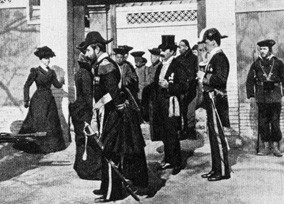 Italian state representatives, Tientsin 1902 |
The Savoy government decided to implement the growth of missions, communities and commercial companies in those new settlements by sending diplomatic attachés and one special military force in charge of the protection of those tricolour territories. In 1915, when Italy entered the war against the Central Powers, the colony of Tientsin counted about 10,000 inhabitants (Chinese) and 350 to 400 Italians, most of whom were traders. At that time the defence of the settlement was entrusted to only ca. 200 soldiers and officers (mostly Bersaglieri) supported by a special battalion (composed of Austro-Hungarian POWs of Italian origin captured in Galizien by the Imperial Russian troops and then released and transferred by train to Far East to reinforce the Italian garrison in China) and by some fifty Chinese militiamen. A few years later, when the war ended, the government of Rome finally decided to strengthen the garrison with a well-armed and trained intervention force. On 5th March 1925 the Battaglione Italiano in Cina was ready to be shipped to China. It was a very skilled unit, mostly composed of soldiers of the elite Reggimento San Marco. The battalion was quartered in the new barracks named Ermanno Carlotto and consisted of three companies of 100 men each: the San Marco Company, the Libia Company and the San Giorgio Company.
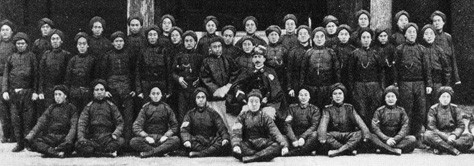 Chinese Militiamen in Italian colonial service, Tientsin 1915 |
The companies received their names from the regiments or naval vessels who gave the troops. This unit, initially under the command of Captain of the Corvette Alberto da Zara, succeeded several times in defending the interests and safety of the Italian colony, particularly from the end of 1937 when as we shall see later on the relationship between Italy and China began to worsen rapidly.
On 18th April 1928, the San Marco
Company was inspected by the former Chinese emperor Pu-Yi during his
visit to the Italian settlement. At the beginning of the 30s, the Italian
colony began to steady, also thanks to the good diplomatic relationship
set between Rome and Beijing and also to the improvement of the trading
and technical exchange set up between the two countries (the Chinese
government even entitled two Italians, Gibello Socco and Evaristo
Caretti, respectively for the direction of the Ministry of Railways and
the Ministry of Post). Tientsin as well as the Italian quarters of
Shanghai and Beijing had quite a serene period during the first half of the
1930s, characterised by fairly good commercial town planning and
entrepreneurial growth. With the arrival of Mussolini's son-in-law
Galeazzo Ciano appointed secretary at the Beijing legation and then
minister plenipotentiary in Shanghai this process improved further,
together with the relationship between Rome and the new Chinese leader
Chiang Kai Shek. In particular, Ciano became close friends with a
leading exponent of the Chinese nationalist's military elite,
Marshall Chang Hsueh Liang, a true admirer of the Mussolini's fascist regime.
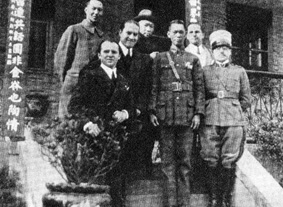 Galeazzo Ciano during his visit to Shanghai, 1935 |
In 1932, soon after the Mukden incident (the first act of Japan's clear hostility against China), to prove once more the friendship towards Italy Chiang Kai Shek, chose Ciano as a go-between with the Japanese representative. In 1932 - under Ciano's pressure for creating an even stronger economic and military alliance between China and Italy the Italian shipping company Lloyd Triestino opened a new service linking Italy to Shanghai by scheduling on that route two modern trans-atlantic vessels, the Conte Biancamano and the Conte Rosso (which immediately set a speed world record of only 23 days during the first voyage). With this new service, supported by those of other companies employed in the trade of various goods and products, the economic exchange between Italy and China reached such good levels to alarm Great Britain and France.
It was in that period that Italy started to provide Beijing with military aircraft. After he presented Chiang Kai Shek with a three-engined Savoia Marchetti, Mussolini sent to China a huge delegation of pilots, engineers, technicians and trainers to convince Nanking's government and the young Chinese aviation representatives to purchase Italian military airplanes and to accept the survey for the creation of factories to build purpose licensed models offered by Rome. The Italian aeronautical delegation, commanded by General Roberto Lordi and composed of renown aces and test pilots such as Valentino Cus and Mario Bernardi (who become famous thanks to his speed record of 700 km/h set by his special Macchi hydroplane) did not succeed in its goal. The Chinese government decided in fact to purchase only a small number of Fiat CR32 and some bomber-recon planes: Caproni Ca101, Ca111 and Ca133. On 6th November 1937 when Italy joined the Anticomintern Pact - the relationship between the two countries suddenly changed. Mussolini, by signing that agreement, got close to Tokyo, opening a series of good exchanges with powerful Japan, which in the meantime had become the worst enemy of weak Nationalist China. It goes without saying that Chiang Kai Shek did not like this decision at all and broke off any relationship with Rome.
The new situation caused the immediate isolation of the Italian colony of Tientsin and the quarters of Shanghai and Beijing, which immediately felt hostility from all around. The military responsible for the colony and the Partito Nazionale Fascista's representatives (at that time in China the party's secretary was Carlo Fumagalli) soon realised the dangerous situation, considering the insufficient Italian forces set to defend the garrison. They immediately demanded from Rome an urgent reinforcement of men and warships. This request was fulfilled in quite a short time, even if it was donr with a small quantity, but unfortunately not before the war between China and Japan broke out. Some months before, in July 1937 - when the first fights had started between Japanese and Chinese troops - Commander Bacigalupi of the gunboat Lepanto became in charge of the first Italian defence detachment, composed by part of the Ermanno Carlotto's and Lepanto's crews. The Tientsin based Battaglione Italiano in Cina soon joined these forces. A few months later when the well-trained and combat hardened Japanese armies had spread over Chinese territory - the Italian Comando Supremo decided to send more forces (some hundreds of soldiers) and the light cruiser Raimondo Montecuccoli to Tientsin. This cruiser sailed from Napoli on August 27th and arrived in Shanghai on September 15th, coinciding with the first Japanese aerial bombing of the town. By then, at least 1,200 Army and Navy soldiers were in China to defend the safety and the interests of its 500 to 600 resident compatriots.
On the whole, in 1937, in Tientsin and Shanghai there were stationed 764 men with officers and soldiers of Battaglione Granatieri di Sardegna arriving by ship from Massaua (Eritrea). Part of these troops supported the English (2,500 men) and the American (1,400 men) contingents who were already in Beijing and particularly in Shanghai to protect the Anglo-Saxon citizens (in Shanghai there were 308 American civilians, 971 English, 199 Germans, 654 Japanese, 182 Russians and 42 Italians). On September 27th and October 24th, some Japanese Mitsubishi bombers attacked the Italian light cruiser Montecuccoli during a raid against Shanghai. During these two missions the Italian vessel was hit by splinters and had one dead and several injured (the incident seriously compromised the diplomatic relationship between Rome and Tokyo). On August 6th 1937, the Italian Comando Supremo decided to move 30 soldiers stationed in Shanghai and Hankow to protect the local Italian consulate. This small group was transferred to its destination from the Montecuccoli, which definitely left China for Italy on August 29th. On December 23rd the cruiser was replaced by its sister vessel, the light cruiser Bartolomeo Colleoni, which stood in defence of the Italian garrisons in China until 5th September 1939, when it was called back to Italy due to the outbreak of the Second World War In the same year, part of the contingent (composed of troops of the Air Force, Carabinieri and Guardia di Finanza (i.e. Revenue Guard Corps)) was repatriated, leaving to the garrison part of the weaponry and two small naval units (the gunboats Lepanto and Carlotto in Shanghai and Tientsin).
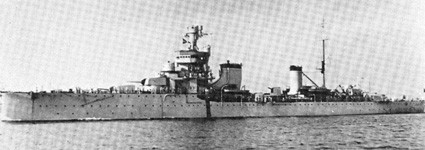
After the Italian declaration of war (10th June 1940), the Navy's Comando Supremo ordered some Massaua-based units to sail to Far East. This decision was made due to the well-grounded fear that in case of the fall of the East Africa Empire, the English could have had the chance to get hold of the Italian ships. Thus, in February 1941 (less than two months before the British capture of the Massaua's base) the colonial ship Eritrea (armed with four 120 mm, two 40 mm guns and two 13.2 mm machine guns) and two armed vessels (Ramb 1 and Ramb 2: two modern and fast banana-carriers converted into auxiliary cruisers by the equiping wirh four 120 mm guns and some 13.2 mm anti-aircraft machine guns) sailed to Kobe (Japan) and, as alternative, the ports of Shanghai and Tientsin. While the Eritrea and the Ramb 2 reached their destination, avoiding the patrolling of the Royal Navy, the Ramb 1 met with the New Zealand light cruiser Leander off the Maldives Islands, by which it was sunk.
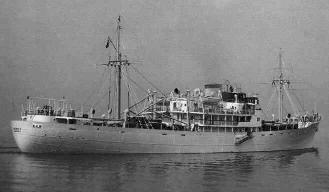
Between March 1941 and September 1943 the Italian concession of Tientsin and the consulates of Shanghai, Hankow and Beijing lived in a quite peaceful period, in spite of a not optimal relationship with the Japanese military occupation command. This last, in fact, did not like the presence of Europeans - even if Japanese allies like the Italians - in the government of towns or even quarters located in their zone of influence. Notwithstanding this, the Italian military attaches and diplomats in China and Japan tried to lower as much as possible the reasons of friction, even when Tokyo forbade to Eritrea and Ramb 2 to carry out offensive cruises against the English fleet in the Pacific Ocean (the Japanese, at least until 7th December 1941 - the date of the unexpected attack on Pearl Harbor - did their utmost in order to avoid whichever embarrassing situation with the USA and Great Britain). Only after Japan's official entering into the war, was Eritrea allowed to lend support to the Italian oceanic submarines reaching Penang and Singapore from the far base of Bordeaux, loaded with strategic products and goods destined to the Japanese war industry. Concerning the many Italian cargo ships which were within Chinese and Japanese waters when Italy entered the war allied to Germany against Great Britain and France, most of them (such as the large steamer Conte Verde) remained unemployed or had to perform voyages for the Japanese, while some others tried to reach the French coast (Bordeaux), by breaking the British blockade. Some of these latter succeeded in their goal, carrying to Europe quite good quantities of strategic cargoes (rubber, quinine, tin).
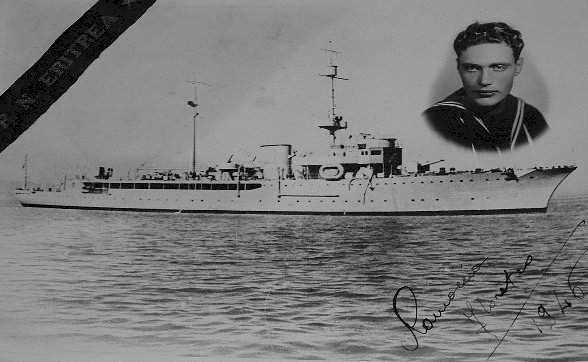
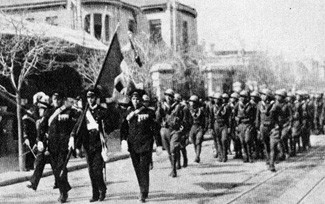 Italian soldiers in Tientsin, 1939 |

Also after the surrender of Germany, in May 8th 1945, about twenty Italian sailors continued the war allied with Japanese. The submarine Torelli was operative until August, 30th, 1945 when in Japan waters, the anti-aircraft guns of this last Italian unit in the Far East succeeded in downing an American B-25 Mitchell bomber, that was also the last victory of a "Japanese" naval unit.
The armistice was a surprise for all Italian Army units in China. The Japanese soldiers soon took revenge against them. Beijing Radio Station (defended by 100 Italian sailors and troopers under the command of Captain of the Corvette Baldassarre and armed only with rifles and hand grenades) resisted for 24 hours. Attacked by almost 1,000 Japanese soldiers supported by 15 light tanks and some guns, the small garrison surrendered at 9 a.m. of 10th September, after having destroyed the radio system and having burned all the top secret documents.
Nevertheless most of the Italians decided to continue the war on the German and Japanese side except for 29 officers and soldiers who refused to do so. They were interned in a prison camp in Korea, where they had very hard treatment.
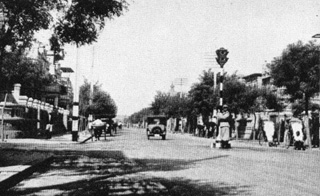
Italian Army units in Tientsin (commanded by Captain of the Frigate Carlo dell'Acqua), surrounded by an entire Japanese infantry regiment commanded by Lieutenant Colonel Tanaka (a force consisting of ca. 6.000 men with ten light armoured vehicles and a lot of field guns), decided at first to try a desperate resistance. Italians who wanted to protect the numerous civilians, among them was also Italian consul Stefanelli, entrenched themselves in Ermanno Carlotto barracks in the Forum and in the town hall deploying ca. 600 soldiers and sailors armed with 300 rifles, 50 pistols, 50 Breda and Fiat machine guns (light and heavy), four 76.17 mm Guns and four Lancia armoured cars. The Italian group also had five motor vehicles, about 50 horses, 2 million bullets (of varied calibre) and food and medicine for about a week.
Lieutenant Colonel Tanaka who had under his command also two river gunboats and a bomber squadron deployed in the nearby Beijing airport summoned the Italians to surrender. At first the Italian officers refused the ultimatum and the Japanese at first shot some gun shells for intimidation. At the same moment the Italians heard the news of the imminent arrival of an entire Japanese Infantry Division with tanks and a lot of artillery at Tientsin. The commander, Captain of the Frigate dell'Acqua, in spite of the opinions of many of his soldiers who wanted to carry on the fight, decided to surrender. What happened to the Italian prisoners was adventurous. About 170 of them joined the fascist Italian Social Republic (R.S.I.) and continued to fight on the German and Japanese side while the rest of the Italian soldiers opted not to collaborate and were interned in prison camps in Tientsin, in Korea and in Japan where they were subjected to hard labour.
Many Italian soldiers who had decided not to collaborate with the Japanese were, after the Japanese surrender (September 1945),
again captured by the Americans and interned in prison camps in the Philippines (near Manila) and in Honolulu (Hawaii).
The last Italians (collaborators and non-collaborators) of the Far East Expedition Corps returned to Italy
(to the port of Napoli) in March 1946 aboard US Navy ships.
